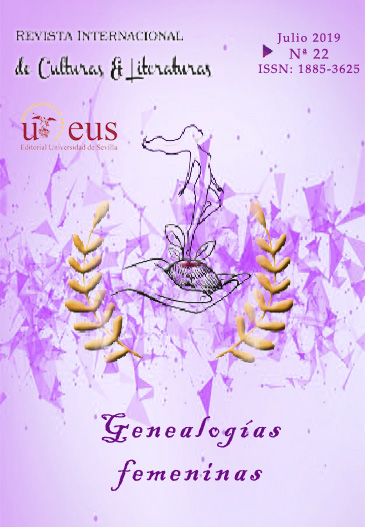ALEXANDER PAYNE’S NEBRASKA AND THE RETURN OF THE GRAND NARRATIVES
DOI:
https://doi.org/10.12795/ricl.v0i22.8357Palabras clave:
Alexander Payne, post-postmodern, cinema, New Sincerity, transcendentalismResumen
This article analyses Alexander Payne’s film Nebraska from the perspective of the paradigm shift produced after the much-debated passing of postmodernism, announced by theorists such as Ihab Hassanor Linda Hutcheon. We shall examine how the lack of grand narratives makes it almost impossible to give structured meanings to the concept of reality. Payne’s project can beviewed as both an allegorical and a physical journey that takes the character to no specific
destination in his search to make amends with the harsh reality that, ultimately, spells the end of the American Dream.
Descargas
Citas
Auster, P., The Brooklyn Follies, 2nd ed., London, Faber & Faber, 2006.
Boxall, P., Twenty-First-Century Fiction: A Critical Introduction, Cambridge, Cambridge University Press, 2013.
Emerson, R. W., Nature, in The Norton Anthology of American Literature, vol. 1. 5th ed., edited by Nina Baym et al., New York, Norton. (1836) 1998, pp.1073-1101
Gross, L., “An American Dream. Alexander Payne Rises to New Heights with Nebraska. A Cinematic Ballad of Loss and Comic Indignity,” Film Comment, 49:5 (2013), pp. 26–28.
Habermas, J., “Modernity versus Postmodernity,” translated by Seyla Ben-Habib, New German Critique 22 (1981), pp. 3-14.
Houx, D., “Director Alexander Payne on Nebraska,” Alexander Payne: Interviews, edited by Julie Levinson. Jackson, University Press of Mississippi, 2014, pp. 216-220.
Jencks, C., The language of post-modern architecture, New York, Rizzoli, 1977.
Kelly, A., “David Foster Wallace and the New Sincerity in American Fiction,” Consider David Foster Wallace: Critical Essays, edited by David Hering. Los Angeles, Sideshow Media Group Press, 2010, pp. 131-146.
Kuhn, T. S., The Structure of Scientific Revolutions, Chicago, University of Chicago Press, (1962) 1970.
Payne, A. (Dir.), Citizen Ruth, Independent Pictures and Miramax, 1996.
Payne, A., “Declaration of Independents,” Variety, September 8 (2004). Internet. 30-08-18. <https://variety.com/2004/scene/markets-festivals/declaration-of-independents-1117910104/>.
Payne, A. (Dir.), Election, Bona Fide Productions, MTV Films and Paramount Pictures, 1999.
Payne, A. (Dir.), About Schmidt, New Line Cinema, 2002.
Payne, A. (Dir.), Sideways, Fox Pictures, 2004.
Payne, A. (Dir.), The Descendants, Fox Pictures, 2011.
Payne, A. (Dir.), Nebraska, Paramount Vantage, 2013.
Randall, Eric, “The ‘Death of Irony,’ and Its Many Reincarnations,” The Atlantic, September 9 (2001). Internet 30-08-18. <https://www.theatlantic.com/national/archive/2011/09/death-irony-and-its-many-reincarnations/338114/>.
Sánchez-Escalonilla, A., “The crisis of the American Dream in new century independent cinema: Indiewood and the recovery of the ordinary citizen (2002-2015),” Communication & Society 29:1 (2016), pp. 21-35.
Sánchez-Escalonilla, A., & Echart, P., “Tales of Rebirth: Alexander Payne and the New American Dream.” Journal of Popular Film and Television 44:2 (2016), pp. 99-108.
Sconce, J., “Irony, Nihilism and the New American ‘Smart’ Film,” Screen 43:4 (2002), pp. 349-369.
“U.S. Declaration of Independence.” National Archives. Internet 29-08-18. <https://www.archives.gov/founding-docs>
Vermeulen, T., & van den Akker, R., “Notes on Metamodernism,” Journal of Aesthetics & Culture 2.0 (2010). Internet 27-07-18. <https://www.tandfonline.com/doi/abs/10.3402/jac.v2i0.5677?needAccess=true#aHR0cHM6Ly93d3cudGFuZGZvbmxpbmUuY29tL2RvaS9wZGYvMTAuMzQwMi9qYWMudjJpMC41Njc3P25lZWRBY2Nlc3M9dHJ1ZUBAQDA=>
Wallace, D. F., “E Unibus Pluram: Television and US Fiction,” Review of Contemporary Fiction 13:2 (1993), pp. 151-194.

